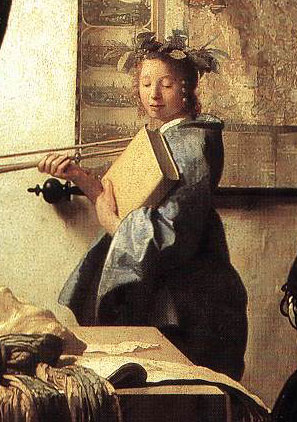
BAROQUE ART
Unit Overview
In this unit, you will study Baroque art and the history behind the movement. You will then take a closer look at Vermeer’s technique and his use of the camera obscura.
I. Baroque
The word “Baroque” means “irregular, contorted, grotesque.” Once you see the beautiful sculptures and paintings this period produced, you will wonder why it is called “Baroque.” This is because the meaning of the word has been disregarded by modern scholars, but the word itself is still used.
The art during this period was a mixture of various philosophic and religious movements. There is a dispute among scholars as to whether the Baroque is the final stage of the Renaissance, or an era distinct from the Renaissance and the modern. Spanning from 1600-1750, the styles expressed were both from Catholic and Protestant perspectives. The Protestant Reformation succeeded in separating itself from the Church, and the Church launched its own Counter-Reformation. When thinking of the Baroque period, it is hard to pinpoint one central idea that defines the entire movement. Therefore, it is good to understand at least some of the basic features- the newly fortified Catholic faith, the absolutist state, and the new role of science. These things distinguish the Baroque period from what had gone before.
II. Vermeer's camera obscura
The most striking feature in Vermeer’s best paintings is their luminosity. He generally applied gray or ochre base layers to his canvas, which supported and established the color harmonies of his compositions. He was keenly aware of the optical effects of color.
The highlights Vermeer achieved are comparable to those seen in a camera obscura, a fascinating optical device that operates much like a box camera. In the 17th century, the camera was constructed with a box that has a fitted lens and focusing tube. The light would enter through the opening and an image was created- though it was a hazy image with unfocused areas around the edges. Vermeer seems to have been fascinated by these optical effects, as his paintings are full of hazy highlights.
For more information about Vermeer, visit this webpage: www.vermeerscamera.co.uk/home.htm (PDF)
Would you like to make your own camera obscura? It’s very easy- click on the PDF file below for instructions. You’ll need only a few household items, and an empty Pringles can.

Now answer questions 1-23.
III. Timeline
You are required to pick TWO works of art from each unit and add them to your timeline.When you have done so, you will upload your word document to the question section so that your teacher can check on it. Add on to the timeline you received in the first unit.

Now answer question 24.
 |
| Unit 8 Cornell Notes Worksheet |